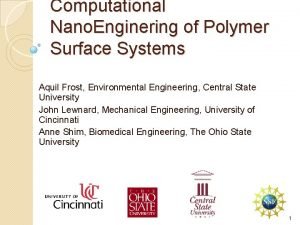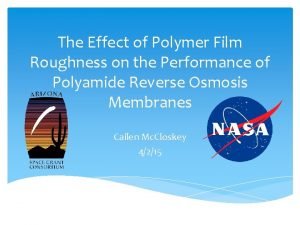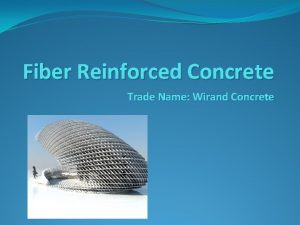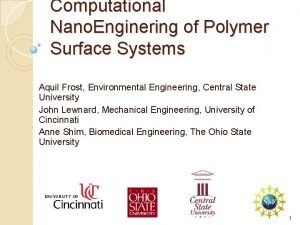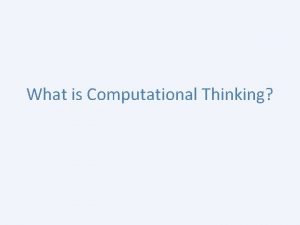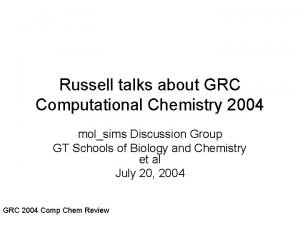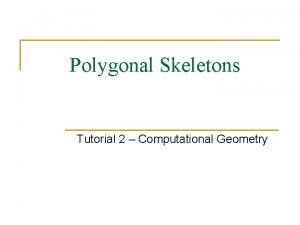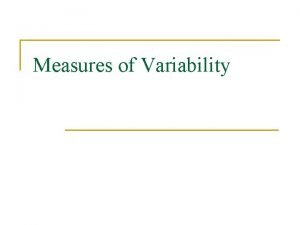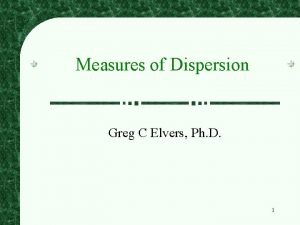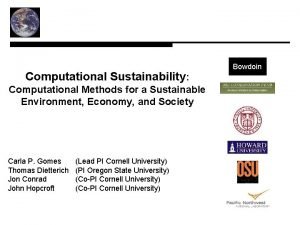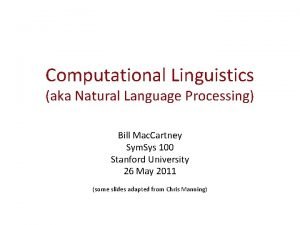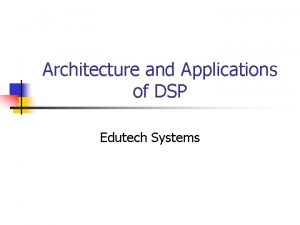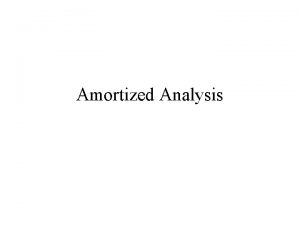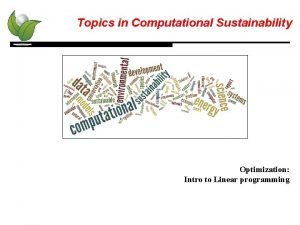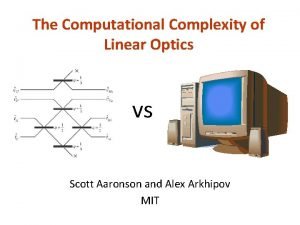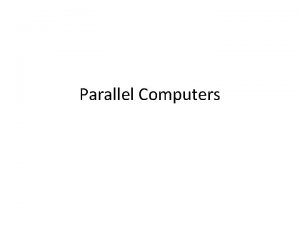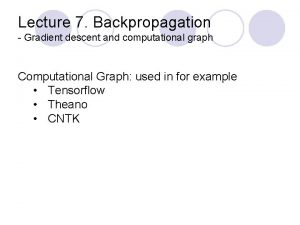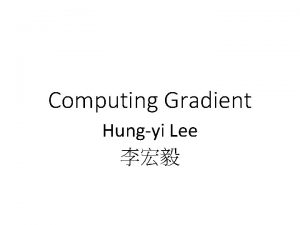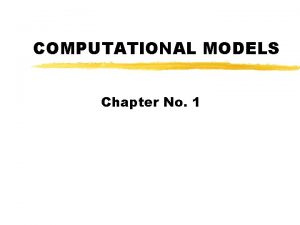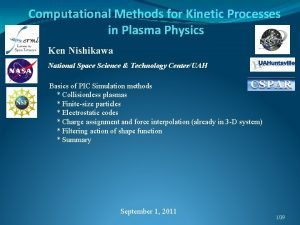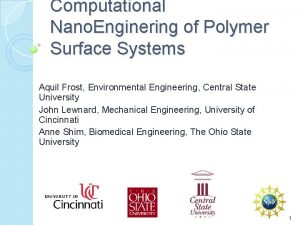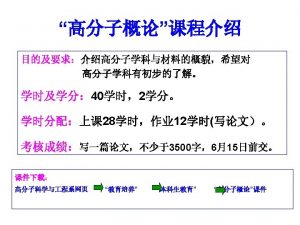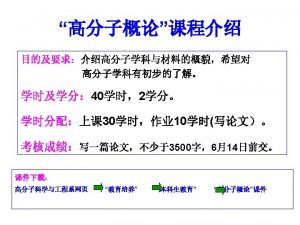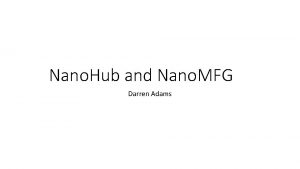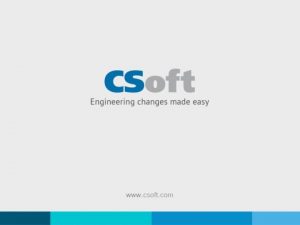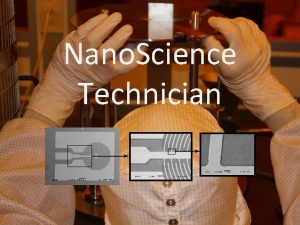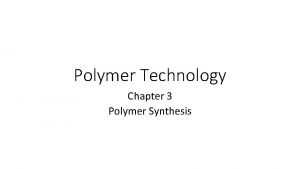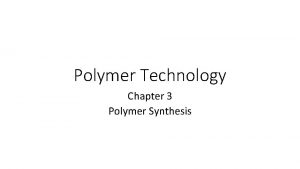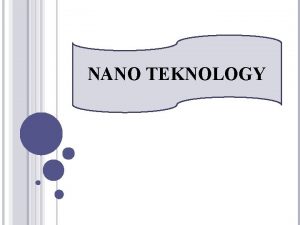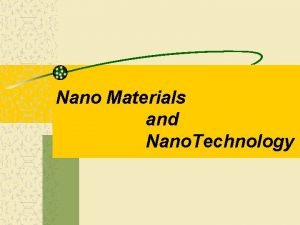Computational Nano Enginering of Polymer Surface Systems Aquil

![Polymers in the Real World [10] [12] [11] [13] 2 Polymers in the Real World [10] [12] [11] [13] 2](https://slidetodoc.com/presentation_image_h/0c5bb84432f2c3c8596a19a0f5dc9265/image-2.jpg)
![Why Simulations? �“Because they provide the freedom to fail!” • Cost • Time [1] Why Simulations? �“Because they provide the freedom to fail!” • Cost • Time [1]](https://slidetodoc.com/presentation_image_h/0c5bb84432f2c3c8596a19a0f5dc9265/image-3.jpg)


























![Lennard Jones Potential Equation [2] Energy (v) is a function of distance (r). Interactive Lennard Jones Potential Equation [2] Energy (v) is a function of distance (r). Interactive](https://slidetodoc.com/presentation_image_h/0c5bb84432f2c3c8596a19a0f5dc9265/image-30.jpg)




![What will this save? �Time [7] �Effort [8] �Money [9] 35 What will this save? �Time [7] �Effort [8] �Money [9] 35](https://slidetodoc.com/presentation_image_h/0c5bb84432f2c3c8596a19a0f5dc9265/image-35.jpg)
![Works Cited [1] (2010). “Polymers”, Chemical of the Week, <http: //scifun. chem. wisc. edu/chemweek/polymers. Works Cited [1] (2010). “Polymers”, Chemical of the Week, <http: //scifun. chem. wisc. edu/chemweek/polymers.](https://slidetodoc.com/presentation_image_h/0c5bb84432f2c3c8596a19a0f5dc9265/image-36.jpg)
- Slides: 36

Computational Nano. Enginering of Polymer Surface Systems Aquil Frost, Environmental Engineering, Central State University John Lewnard, Mechanical Engineering, University of Cincinnati Anne Shim, Biomedical Engineering, The Ohio State University 1
![Polymers in the Real World 10 12 11 13 2 Polymers in the Real World [10] [12] [11] [13] 2](https://slidetodoc.com/presentation_image_h/0c5bb84432f2c3c8596a19a0f5dc9265/image-2.jpg)
Polymers in the Real World [10] [12] [11] [13] 2
![Why Simulations Because they provide the freedom to fail Cost Time 1 Why Simulations? �“Because they provide the freedom to fail!” • Cost • Time [1]](https://slidetodoc.com/presentation_image_h/0c5bb84432f2c3c8596a19a0f5dc9265/image-3.jpg)
Why Simulations? �“Because they provide the freedom to fail!” • Cost • Time [1] �“Assess real-world processes too complex to analyze via spreadsheets or flowcharts” [2] 3

What can we see? Time Macro Meso Nano Subatomic Size 4

Timeline Week 1 Week 2 Week 3 Week 4 Week 5 Week 6 Week 7 Week 8 Training Literature Review Create Surfaces Create Polymers Run Simulations Analyze Simulations Work on Deliverables Finish Research Paper Finish Final Presentation Finish Research Poster 5

Programs Used Visual Molecular Dynamics Large-scale Atomic/Molecular Massively Parallel Simulator 6

POLYMER GENERATION 7

What Are Polymers? � Consist of repeating units called “monomers” � Polymer industry is larger than the aluminum, copper, and steel industries combined [4] 8

Polymer Adsorption 9

Using MATLAB to Generate “On. Lattice” Polymer Chains 10

Using MATLAB to Generate “Off. Lattice” Polymer Chains 11

CREATE SURFACES 12

Surfaces 1. Regular, Rough Oscillations in the x direction: 2 Oscillations in the y direction: 2 Amplitude: 0. 1 Oscillations in the x direction: 1 Oscillations in the y direction: 1 Amplitude: 0. 5 13

Surfaces 2. Random, Roughness Factor: 0. 1 Roughness Factor: 0. 9 14

Testing Surfaces www-ee. ccny. cuny. edu 15

Face Centered Cubic with MATLAB 3 rows, 3 columns, Depth of 1 16

Face Centered Cubic with MATLAB 3 rows, 3 columns, Depth of 1 17

Problems? �It’s not that simple! 18

Brownian Fields �Created Using Fractals �Fractals are a mathematical concept: ◦ Self similar with a change of scale (magnification) 19

Brownian Field Uses Fractals �Since Brownian Field has holes or gaps we have simulated a FCC structure using fractals: 20

Surface Area �Using axb = Ia. IIb. Isin(Ø) (Area) we find area between those two vectors. 21

RUN SIMULATIONS 22

LAAMPS File 23

Polymer Adsorbing onto Surface http: //www. technewsworld. com/story/71829. html Polymer is randomly placed around surface while data is take 24

Polymers are Constantly Moving Surface 25

RUN ANALYSIS 26

Analysis �In order to receive usable data – all variables must be controlled except one �Independent Variable: ◦ Roughness �Dependent Variables: ◦ Entropy ◦ Energy �Controlled Variables: ◦ Surface Area ◦ Polymer make-up ◦ Surface make-up 27

Entropy �Entropy – How many options does the polymer have? ◦ At bottom of trough – the polymer is compact - order �Not many options ◦ At top of trough – the polymer is free to move - chaos �A lot of options 28

Energy vs. Distance Analysis – “The Sweet Spot” 29
![Lennard Jones Potential Equation 2 Energy v is a function of distance r Interactive Lennard Jones Potential Equation [2] Energy (v) is a function of distance (r). Interactive](https://slidetodoc.com/presentation_image_h/0c5bb84432f2c3c8596a19a0f5dc9265/image-30.jpg)
Lennard Jones Potential Equation [2] Energy (v) is a function of distance (r). Interactive Force (Epsilon) Diameter of atom (sigma) 30

Lennard Jones Potential Equation Energy Distance 31

What does this analysis tell us? �The extent at which a polymer exists at a certain entropy level ◦ Depends on roughness �The distance that leads to the lowest energy potential ◦ Where is that “sweet spot? ” 32

Example: Conditioner! http: //www. naturalcosmetic news. com/recent-news/pgintroduces-pantene-plantbased-plastic-bottles/ 33

How does this information help us? �In the development of conditioner: ◦ What is the total change in entropy of the conditioner when adsorbing onto hair? ◦ What is the distance from conditioner to hair that achieves the lowest energy level? �If P&G knew these things they could make better conditioner! 34
![What will this save Time 7 Effort 8 Money 9 35 What will this save? �Time [7] �Effort [8] �Money [9] 35](https://slidetodoc.com/presentation_image_h/0c5bb84432f2c3c8596a19a0f5dc9265/image-35.jpg)
What will this save? �Time [7] �Effort [8] �Money [9] 35
![Works Cited 1 2010 Polymers Chemical of the Week http scifun chem wisc educhemweekpolymers Works Cited [1] (2010). “Polymers”, Chemical of the Week, <http: //scifun. chem. wisc. edu/chemweek/polymers.](https://slidetodoc.com/presentation_image_h/0c5bb84432f2c3c8596a19a0f5dc9265/image-36.jpg)
Works Cited [1] (2010). “Polymers”, Chemical of the Week, <http: //scifun. chem. wisc. edu/chemweek/polymers. html>(May 31, 2013). [2] (2010). “Lennard-Jones Potential”, UCDavis. Chem. Wiki, <http: //chemwiki. ucdavis. edu/Physical_Chemistry/Quantum_Mechanics/Atomic_Theory/ Intermolecular_Forces/Lennard-Jones_Potential>(May 31, 2013). [3] (2012). “Solutions: Simulation Software Overview. ” Imagine That!, <http: //www. extendsim. com/sols_simoverview. html#monte. Carlo>(May 29, 2013). [4] (2012). “What are Polymers? , MAST, <http: //matse 1. matse. illinois. edu/polymers/ware. html>(May 31, 2013). [5] (2013). “Why Simulations? ” TATA Interactive Systems, <http: //blog. tatainteractive. com/2013/01/why-simulations. html>(May 29, 2013). [6] Landau D. P. Binder K. (2000). “Introduction, ” “Simple Sampling Monte Carlo Methods , “Monte Carlo Simulations in Statistical Physics, Press Syndicate of the University of Cambridge, United Kingdom, 1 -6, 48 -67 [7] http: //www. empowernetwork. com/teameaglefreedom/blog/the-clock-is-ticking-tic-toc-tictoc/ [8] http: //emotibot. net/? i=504 [9] http: //www. merchantcircle. com/business/National. Lawsuit. Funding. 302 -7921400/picture/view/3137972 [10] www. idahofamilyvision. com [11] www. plasticstoday. com [12] carterpaintingboulder. com [13] www. pennysimkin. com 36
 Engineering and scientific notation
Engineering and scientific notation Enginering design
Enginering design Polymer tech systems 2412
Polymer tech systems 2412 Surface roughness of polymer film
Surface roughness of polymer film Partially impregnated and surface coated polymer concrete
Partially impregnated and surface coated polymer concrete Polymer tech systems 2412
Polymer tech systems 2412 What's lateral surface area
What's lateral surface area High surface tension vs low surface tension
High surface tension vs low surface tension Curved surface area and total surface area of cone
Curved surface area and total surface area of cone Characteristics of computational thinking
Characteristics of computational thinking Computational thinking algorithms and programming
Computational thinking algorithms and programming Grc computational chemistry
Grc computational chemistry Using mathematics and computational thinking
Using mathematics and computational thinking Straight skeleton algorithm
Straight skeleton algorithm Usc neuroscience
Usc neuroscience Standard deviation computational formula
Standard deviation computational formula Standard deviation computational formula
Standard deviation computational formula Computational math
Computational math Algorithmic thinking gcse
Algorithmic thinking gcse Computational sustainability scope
Computational sustainability scope Chomsky computational linguistics
Chomsky computational linguistics Xkcd computational linguistics
Xkcd computational linguistics Cmu computational biology
Cmu computational biology Dsp computational building blocks
Dsp computational building blocks Amortized time big o
Amortized time big o Computational sustainability subjects
Computational sustainability subjects The computational complexity of linear optics
The computational complexity of linear optics Leerlijn computational thinking
Leerlijn computational thinking Computational speed
Computational speed Computational graph
Computational graph Computational graph
Computational graph Computational thinking jeannette wing
Computational thinking jeannette wing Computational radiology
Computational radiology Computational photography uiuc
Computational photography uiuc Computational neuroethology
Computational neuroethology Computational model in computer architecture
Computational model in computer architecture Computational methods in plasma physics
Computational methods in plasma physics


